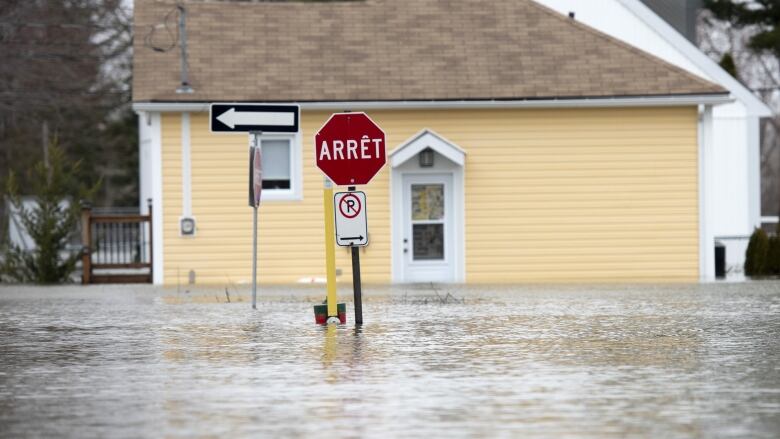Climate change and poor planning are fuelling more floods. Here's what we can do about it
It's high time that governments at all levels figure out how to mitigate the costly impact, experts say

For most people, the early days of spring conjurepleasant thoughts: blue skies, singing birds, sunshine, warmth and blooming flowers. But for many, the spring thaw is a time of dread. It's a time of floods.
Over the past few weeks, communities in New Brunswick, Ontario and Quebec have made headlines as severe flooding forced many people to abandon their homes.
The spring flood season isn't anything new to Canada: the Red River consistently floods in Manitoba, as does the Bow River in Alberta.
But what's different, experts say, is that spring flooding is becoming more common and will likelyget even more severein some parts of the country.
"The extreme rain, precipitation events that are occurring now are going to continue and indeed are going to get worse going forward for sure," said Blair Feltmate, head of the Intact Centre on Climate Adaptation at the University of Waterloo.
"Because a certain proportion of that which is driving these events is climate change itself. So we're getting more storms of greater magnitude, of greater intensity [and] higher volumes of water coming down over shorter periods of time."

Feltmate is also the chair of the federal government's Expert Panel on Climate Change Adaptation and Resilience, which has been examining the role climate change is playing and will continue to play across the country.
But there are other factors to consider, including how we're using our land.
In cities, for example, all that concrete helps preventwater from being absorbed quickly.
Rural areas may look greener, but land used for agriculture has changed the landscape and prevented natural vegetation that might have otherwise absorbed melting snow and rainwater.

"Here in Ontario and the trend is the same right across Canada we've lost 73 per cent of the original, natural infrastructure that was here 100 years ago: forests, fields, wetlands, marshes," Feltmate said. "That's disappeared. That's either been paved over or turned into agricultural development such that when the big storms hit, water isn't absorbed quickly on these new surfaces."
David Phillips, senior climatologist at Environment and Climate Change Canada, said thatwhile Canada has experienced these kinds of floods before, for some areas, it's been the level of extended cold that's made all the difference.
In Ottawa, for example, the city has had six months that have been colder than usual. So, instead of a warmup that might see some gradual melting, the snow is melting all at once, and much of that water has nowhere to go.
According to the recently released Canada's Changing Climate Report, increasingprecipitation levels are expected in the winter months rather than the summer, whichcould make spring flooding even worse.
Next steps
While leaders may be discussing climate change, there needs to be more action, many experts say.
"At the level of communities, what we should be doing is looking at how we can use things like berms, diversion channels, holding ponds, cisterns, bioswales to direct water to safe locations where it can be stored or discharged downstream," Feltmate said.
We should also be looking to preserve natural infrastructure. For example, along riverbanks, it's wiser to keep trees, bushesand grasses that have been there historically to hold back the water rather than to clear it for development.

But of particular concern is the fact that most flood plain maps are out of date, allowing houses to be built in flood-prone areas.
"We don't yet have flood plain maps that are updated across the country," said Deborah Harford, executive director at the Adaptation to Climate Change Teamat Simon Fraser University in Burnaby, B.C. "We should put more pressure on the federal government to produce those, because those impacts are happening already."
Some governments have offered incentives to encourage people to move away from areas at risk of flooding.
In High River, Alta., the provincial government bought homes that were damaged in the 2013 floods and built $100 million worth of berms, floodgates and dikes to protect against any further flooding.
But solving the problem is not as simple as buying out homeowners, Harford said.
While some larger municipalities may be able to offer incentives or the opportunity to buy back land, that may not be so for smaller communities, she said.
"Certain locations where it's going to be untenable, the question is how do we deal with the property loss that owners would face?" she said. "That is a national discussion.
"There is a central question, which is: what are we going to do about the places we can't keep saving?"

All levels of government need to work together to determine the best means of planning for the future of a changing climate, she said.
"The goal posts are continually moving, every year. The events are getting worse and bigger. It's time to stop talking about climate as though it's a separate thing and just mainstream it through all of our urban planning."












_(720p).jpg)


 OFFICIAL HD MUSIC VIDEO.jpg)
.jpg)



























































































